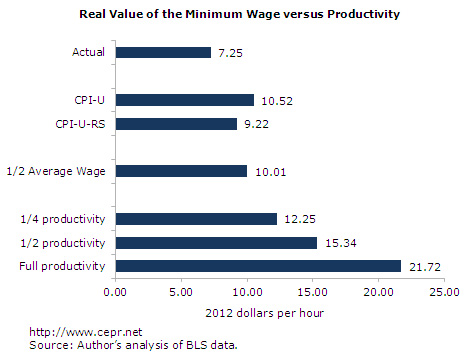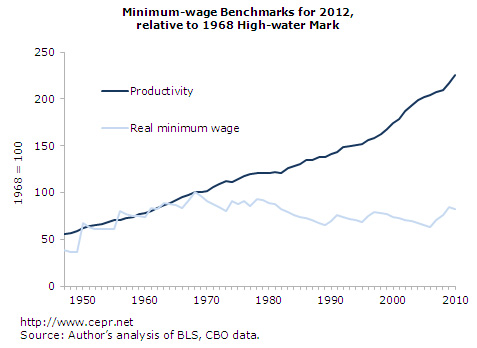It is coming up on three years since the last increase in the
federal minimum wage –to $7.25 per hour– in July 2009.
By all of the most commonly used benchmarks – inflation, average wages, and productivity – the minimum wage is now far below its historical level. By all of these reference points, the value of the minimum wage peaked in 1968. If the minimum wage in that year had been indexed to the official Consumer Price Index (CPI-U), the minimum wage in 2012 (using the
Congressional Budget Office’s estimates for inflation in 2012) would be at $10.52. Even if we applied the current methodology (CPI-U-RS) for calculating inflation –which generally shows a lower rate of inflation than the older measure– to the whole period since 1968, the 2012 value of the minimum wage would be $9.22.

Using wages as a benchmark, in 1968 the federal minimum stood at 53 percent of the average production worker earnings. During much of the 1960s, the minimum wage was close to 50 percent of the same wage benchmark. If the minimum wage were at 50 percent of the production worker wage in 2012 (again, using CBO projections to produce a full-year 2012 estimate), the federal minimum would be $10.01 per hour.

A final benchmark for the minimum wage is productivity growth. The figure below compares growth in average labor productivity with the real value of the minimum wage between the late 1940s and the end of the last decade. Between the end of World War II and 1968, the minimum wage tracked average productivity growth fairly closely. Since 1968, however, productivity growth has far outpaced the minimum wage. If the minimum wage had continued to move with average productivity after 1968, it would have reached $21.72 per hour in 2012 – a rate well above the average production worker wage. If minimum-wage workers received only half of the productivity gains over the period, the federal minimum would be $15.34. Even if the minimum wage only grew at one-fourth the rate of productivity, in 2012 it would be set at $12.25.
By any reasonable measure, there is a lot of room to increase the minimum wage above its current level.
(For a printable version of this blog post, complete with a data appendix, click
here.)





